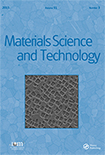
MATERIALS SCIENCE AND TECHNOLOGY
Scope & Guideline
Innovative Discoveries Shaping the World of Materials
Introduction
Aims and Scopes
- Materials Characterization:
The journal emphasizes the study of microstructural, mechanical, thermal, and electrical properties of materials. This includes advanced techniques for analyzing materials at the nanoscale to understand their behavior under different conditions. - Processing and Fabrication Techniques:
Research on various methods for fabricating and processing materials, including additive manufacturing, welding, and casting, is a core focus. The journal explores how these techniques affect material properties and performance. - Advanced Materials Development:
The development of novel materials, including composites, alloys, and nanomaterials, is a significant area of interest. This includes the design and optimization of materials for specific applications, such as aerospace, biomedical, and energy sectors. - Corrosion and Wear Resistance:
Studies related to the durability and longevity of materials in harsh environments are highlighted. This includes examining corrosion mechanisms and wear resistance to improve material performance. - Computational Materials Science:
The journal also covers computational approaches to materials science, such as modeling and simulation techniques that predict material behavior and guide experimental work. - Sustainability and Environmental Impact:
A growing emphasis on sustainable materials and processes, including recycling, waste reduction, and the development of eco-friendly materials, is increasingly reflected in the journal's publications.
Trending and Emerging
- Additive Manufacturing and 3D Printing:
There is a significant increase in research focused on additive manufacturing technologies, exploring new materials and processes that enhance the capabilities and applications of 3D printing. - Nanotechnology in Materials Science:
Emerging studies on nanomaterials and their applications are trending, showcasing their unique properties and potential in various fields, including electronics, energy storage, and biomedical applications. - Sustainable and Green Materials:
Research on environmentally friendly materials and sustainable practices is gaining traction, aligning with global efforts towards sustainability and reduced environmental impact in material production. - Smart and Functional Materials:
The development of materials with intelligent responses to environmental stimuli, such as self-healing or shape memory alloys, is increasingly prominent, reflecting the demand for advanced functional materials. - Machine Learning and AI in Materials Design:
The use of machine learning and artificial intelligence to predict material properties and optimize designs is a growing trend, indicating a shift towards data-driven approaches in materials science. - Biodegradable and Biocompatible Materials:
There is a rising focus on materials suitable for medical applications, particularly those that are biodegradable or biocompatible, reflecting the increasing importance of health and environmental considerations.
Declining or Waning
- Traditional Materials:
There has been a noticeable decrease in research focused on conventional materials such as basic metals and alloys, as newer materials and composites gain more attention due to their advanced properties and applications. - Basic Theoretical Studies:
Research centered around fundamental theoretical frameworks without experimental validation is becoming less common, as the journal increasingly favors studies that integrate theory with practical applications. - Low-Impact Applications:
Papers focusing on low-impact applications of materials, such as basic construction materials without innovative processing or enhancement, are being published less frequently, reflecting a shift towards more high-tech and specialized applications. - Standardized Testing Methods:
Research that only presents standard testing methods without novel insights or applications is on the decline, as the journal seeks more innovative and practical contributions. - Non-Metallic Materials:
Research on non-metallic materials, such as basic ceramics or polymers without advanced modifications or applications, appears to have waned, with a stronger focus now on hybrid and composite materials.
Similar Journals

Acta Metallurgica Slovaca
Unlocking the potential of metals and alloys through open access.Acta Metallurgica Slovaca is a distinguished open-access journal published by SCICELL SRO that has been pivotal in the field of Materials Science and Metallurgy since its inception. With a robust commitment to disseminating high-quality research, this journal covers a wide array of topics within the scope of metals and alloys. Now indexed in Scopus, it ranks 82nd out of 176 in its category, reflecting a growing influence within the scientific community. With a quartile ranking of Q3 as of 2023, Acta Metallurgica Slovaca serves as an essential platform for researchers and professionals seeking to share innovative findings and developments in metallurgical science. Open access since 2013, it ensures that research is accessible to all, fostering collaboration and engagement across academia and industry worldwide. With a converged publication timeline extending from 2009 to 2024, this journal continues to play a crucial role in advancing knowledge and addressing contemporary challenges in the metallurgy sector.
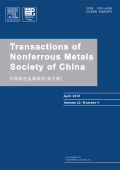
TRANSACTIONS OF NONFERROUS METALS SOCIETY OF CHINA
Elevating the discourse on materials chemistry and engineering geology.TRANSACTIONS OF NONFERROUS METALS SOCIETY OF CHINA, published by Elsevier, is a premier academic journal that serves as a vital platform for researchers and professionals specializing in materials science, condensed matter physics, geotechnical engineering, and engineering geology. Established in 1994, this esteemed publication has maintained a robust focus on the latest developments in the nonferrous metals sector, reflecting its significant impact in the field with a Q1 categorization across multiple disciplines. With impressive Scopus rankings—placing it in the top 20% of journals in relevant categories—this journal is recognized for its quality and rigor, providing critical insights into metals and alloys, materials chemistry, and their applications. The non-open access format ensures a dedicated readership among professionals and academics seeking substantial and authoritative research articles. By fostering knowledge exchange, the journal strives to advance the understanding and application of nonferrous metals, making it an essential resource for anyone involved in material innovations and engineering solutions.
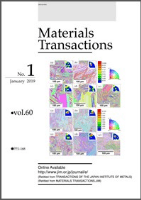
MATERIALS TRANSACTIONS
Exploring Innovations in Materials ResearchMATERIALS TRANSACTIONS, published by the Japan Institute of Metals & Materials, stands as a pivotal journal in the fields of Condensed Matter Physics, Materials Science, and Mechanical Engineering. Operating since 1993, this peer-reviewed journal aims to disseminate high-quality research that advances our understanding of material properties and behaviors under varied conditions. With an ISSN of 1345-9678 and an E-ISSN of 1347-5320, it provides open access options, ensuring that the latest findings are readily available to a global audience. The journal currently holds a commendable Q3 ranking across multiple categories, underscoring its relevance and impact in the respective fields. Located in Sendai, Japan, MATERIALS TRANSACTIONS has emerged as a vital resource for researchers, professionals, and students alike, fostering innovation and collaboration in material science and engineering methodologies. As the demand for advanced materials continues to rise, this journal serves as an essential platform for sharing and discussing cutting-edge research and developments.
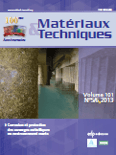
Materiaux & Techniques
Advancing Innovation in Materials ScienceMateriaux & Techniques, published by EDP SCIENCES S A, is a prominent journal in the field of materials science, specifically focusing on diverse and innovative techniques in material development and application. With an ISSN of 0032-6895 and an E-ISSN of 1778-3771, this French journal serves as a key resource for researchers and professionals looking to advance their knowledge and share their findings within the community. The journal holds a Q3 ranking in Materials Science (miscellaneous), indicating its role in contributing to various facets of material science research amidst a growing field. Despite operating under a traditional access model, it provides a platform for rigorous peer-reviewed studies and significant advancements in material technology. With a publication history tracing back to the late 1970s and extending through to 2024, Materiaux & Techniques continues to uphold its commitment to fostering high-quality discourse and innovation in materials science.
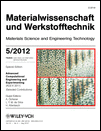
MATERIALWISSENSCHAFT UND WERKSTOFFTECHNIK
Pioneering Research in Material Characterization.MATERIALWISSENSCHAFT UND WERKSTOFFTECHNIK, published by WILEY-V C H VERLAG GMBH, is a prominent journal dedicated to the field of materials science and engineering. With its ISSN 0933-5137 and E-ISSN 1521-4052, this journal serves as a vital resource for researchers and professionals engaged in exploring the intricate relationships between the properties of materials and their applications. Established in 1970 and continuing through 2024, the journal has been consistently recognized in various categories, achieving a Q3 ranking in 2023 across Condensed Matter Physics, Materials Science (miscellaneous), Mechanical Engineering, and Mechanics of Materials. Although it does not offer open access, its high-quality peer-reviewed content is fundamental to the advancement of knowledge within its three key areas: novel material development, material characterization, and application of materials in engineering contexts. As a driving force in the scientific community, MATERIALWISSENSCHAFT UND WERKSTOFFTECHNIK continues to cater to the curiosity of aspiring students, seasoned professionals, and researchers alike, facilitating a deeper understanding of the complexities of material technology.

METALLURGICAL AND MATERIALS TRANSACTIONS A-PHYSICAL METALLURGY AND MATERIALS SCIENCE
Exploring the Dynamics of Metals and AlloysMETALLURGICAL AND MATERIALS TRANSACTIONS A - PHYSICAL METALLURGY AND MATERIALS SCIENCE, published by Springer, is a prestigious journal that plays a pivotal role in advancing the fields of physical metallurgy and materials science. With an ISSN of 1073-5623 and an E-ISSN of 1543-1940, this American journal provides a vital platform for disseminating cutting-edge research and innovative findings relevant to condensed matter physics, mechanics of materials, and metals and alloys. The journal, indexed with an impressive Q1 ranking in multiple categories in 2023, ensures its position among the top-tier publications, making it an essential resource for researchers, professionals, and students alike. Spanning decades of invaluable contributions since its inception in 1975, METALLURGICAL AND MATERIALS TRANSACTIONS A focuses on fostering academic dialogue, promoting collaboration, and showcasing leading-edge discoveries that drive the materials science community forward. Researchers seeking to publish their work in a highly visible forum will find this journal an optimal choice for reaching a discerning audience.

Obrabotka Metallov-Metal Working and Material Science
Bridging Theory and Application in Material ScienceObrabotka Metallov-Metal Working and Material Science is a pivotal journal published by Novosibirsk State Technical University, focusing on the dynamic fields of mechanical engineering, mechanics of materials, and the science of metals and alloys. With ISSN 1994-6309 and E-ISSN 2541-819X, the journal serves as a crucial platform for disseminating research from Russia and around the globe. Currently classified in the Q4 category for Mechanical Engineering and Mechanics of Materials, as well as Q3 for Metals and Alloys, it encompasses a wide range of studies from fundamental research to innovative applications. Despite its relatively recent inception in 2019, the journal has established itself with Scopus rankings that highlight its growing influence—Rank #122 out of 176 in Materials Science and Rank #510 out of 672 in Engineering. This journal aims to foster collaboration among researchers, professionals, and students by featuring original articles, reviews, and technical notes that address contemporary challenges in metal processing and material science. As it continues to evolve through 2024, Obrabotka Metallov remains dedicated to enhancing the understanding and application of materials science, making it a significant resource for those invested in the future of engineering and technology.
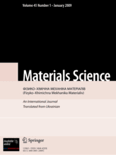
MATERIALS SCIENCE
Fostering Collaboration in the World of Materials.MATERIALS SCIENCE, a prominent journal published by SPRINGER, serves as a vital resource for researchers, professionals, and students in the fields of materials science, mechanical engineering, and condensed matter physics. With its ISSN 1068-820X and E-ISSN 1573-885X, this journal has been dedicated to sharing innovative research since its inception in 1993, and it continues to publish groundbreaking findings through 2024. Although it operates as a traditional subscription-based journal, its ranking in the Q3 quartile across multiple scientific categories, including Condensed Matter Physics, Materials Science, Mechanical Engineering, and Mechanics of Materials, signifies its relevance and impact in the academic community. Notably, its Scopus classifications reveal a competitive standing among its peers, ranking within the 25th to 33rd percentiles across various engineering and physics disciplines. The journal remains a key platform for disseminating valuable insights, fostering collaboration, and advancing the understanding of materials science.

Journal of Metals Materials and Minerals
Fostering Insights in the World of Materials and MineralsJournal of Metals Materials and Minerals (ISSN: 0857-6149) is a renowned academic publication dedicated to the interdisciplinary fields of metallurgical science, materials engineering, and mineralogy. Published by Chulalongkorn University, Metallurgy & Materials Science Research Institute in Thailand, this journal serves as a pivotal platform for researchers to disseminate their findings and explore innovative applications related to metals, ceramics, polymers, and biomaterials. Although the journal does not currently adopt an open-access model, it provides insightful content that facilitates knowledge sharing among professionals and academics alike. The journal has established its credibility with impressive Scopus ranking percentiles, particularly in categories such as Metals and Alloys and Ceramics and Composites. With an emphasis on advancing the understanding of materials science from 2017 to 2024, the Journal of Metals Materials and Minerals remains an essential resource for those striving to contribute to and stay informed about the latest trends and breakthroughs in these dynamic fields.

Letters on Materials
Bridging theory and practice in materials research.Letters on Materials, published by the Russian Academy of Sciences, Institute of Metals Superplasticity Problems, serves as a vital platform in the diverse field of materials science. Established in 2014 and running through 2024, this journal has carved a niche as a Q3 category publication, focusing on innovative research and developments in materials science and engineering. With its ISSN 2218-5046 and E-ISSN 2410-3535, it provides a unique opportunity for researchers and industry professionals to disseminate significant findings and theoretical advancements within the materials domain. While currently not categorized as open access, the journal maintains a global reach, promoting scientific dialogue and collaboration particularly within the Russian Federation and broader international audiences. Its placement within the 25th percentile in the Scopus rankings underscores its emerging significance, making it essential reading for anyone interested in cutting-edge materials research.